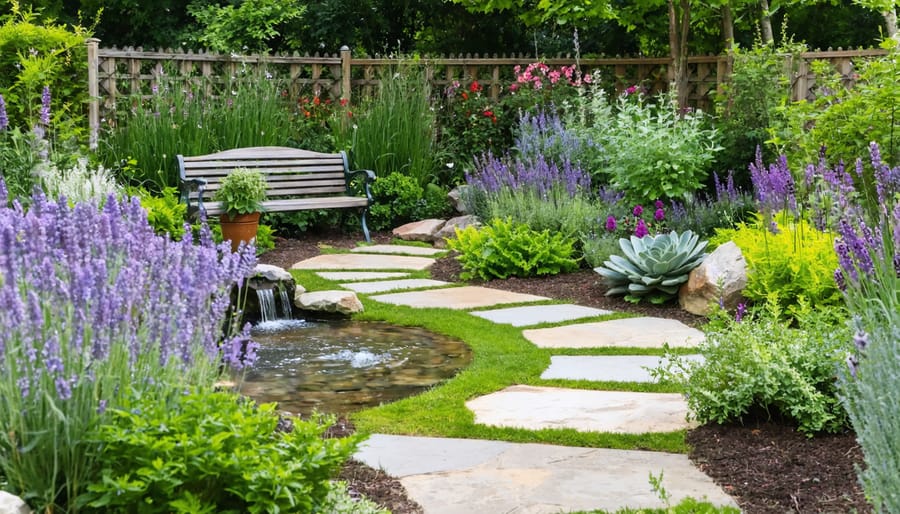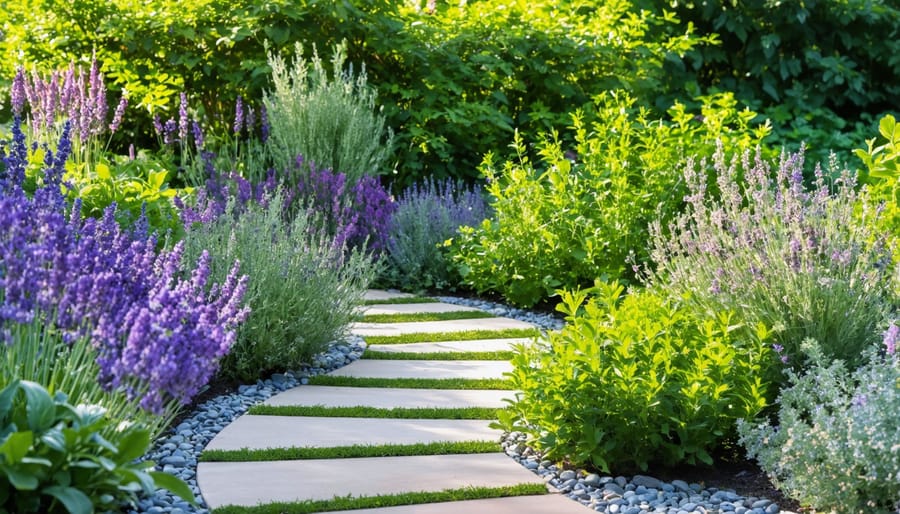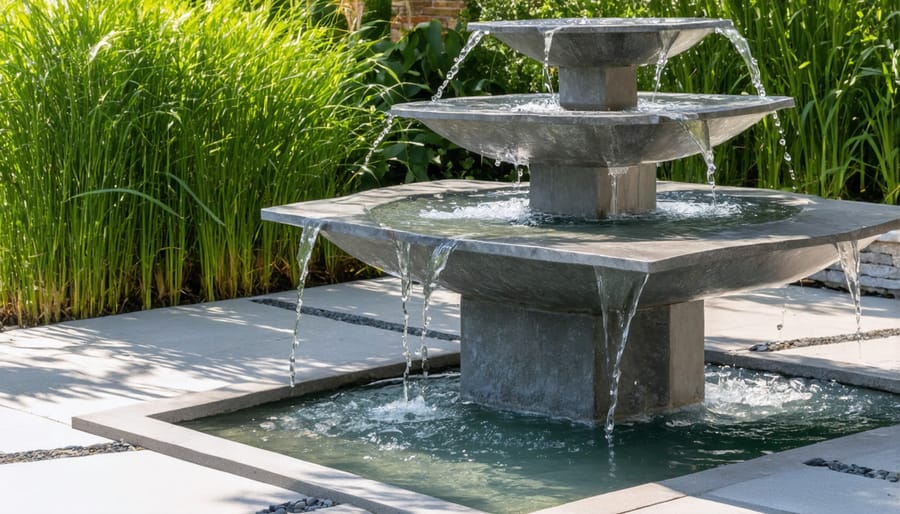Transform Your Backyard Into a Sensory Paradise (Even in Small Spaces)

Transform your backyard into a multi-sensory haven by strategically placing fragrant herbs like lavender and rosemary along winding pathways, installing wind chimes and water features for soothing acoustics, and incorporating textured plants such as lamb’s ear and ornamental grasses. To create a peaceful outdoor space, layer your garden with plants of varying heights, colors, and blooming seasons to engage visual interest year-round. Design accessible raised beds filled with edible plants like mint, strawberries, and cherry tomatoes to invite taste exploration, while tactile elements such as smooth river rocks and rough bark mulch create engaging pathways for hands and feet. Position benches and seating areas strategically throughout to encourage visitors to pause and fully immerse themselves in the sensory experience, making your garden both a therapeutic retreat and an interactive outdoor classroom for all ages.
Touch and Texture: Creating Tactile Adventures
Soft and Fuzzy Plants
Soft-textured plants add an irresistible tactile element to your sensory garden, inviting both children and adults to reach out and touch. Lamb’s ear (Stachys byzantina) is a garden favorite, featuring velvety silver-green leaves that feel like the softest wool. Plant these low-growing perennials along pathway edges where visitors can easily brush against them.
Silver sage (Salvia argentea) offers large, fuzzy leaves with a striking silvery sheen that begs to be touched. For vertical interest, consider Mexican bush sage with its soft, purple flower spikes and downy stems. Angel’s wings (Senecio candicans) provides large, plush leaves that feel like touching a cloud.
Don’t forget about ornamental grasses like feather reed grass and bunny tails, which add movement and a gentle, feathery texture to your garden. For ground cover, try woolly thyme, which creates a soft carpet underfoot and releases a pleasant aroma when stepped on.
Group these touchable plants near seating areas or along frequently traveled paths to maximize interaction. Remember to plant them at different heights, creating opportunities for both standing and seated visitors to enjoy their unique textures.

Natural Texture Elements
Natural textures are the backbone of any sensory garden, offering tactile experiences that engage both children and adults. Start by incorporating different types of stone elements – smooth river rocks for their cool, polished feel, and rough granite pieces that provide an interesting contrast. Layer your pathways with materials of varying textures, such as bark mulch, pebbles, and crushed shells, creating distinct zones that are both visually and physically stimulating.
Consider adding timber elements like log stepping stones or wood chip paths, which not only provide interesting textures but also release pleasant natural aromas when walked upon. Cork bark strips can be integrated into seating areas or vertical elements, offering a unique, soft texture that’s particularly appealing to touch.
Don’t overlook the textural variety that plants themselves can provide. Mix feathery ornamental grasses with broad-leafed plants like lamb’s ear or fuzzy sage. Create contrast by placing rough-textured succulents near smooth-leafed hostas. For vertical interest, consider adding bamboo screens or rough-barked trees that invite exploration through touch.
Remember to arrange these elements at different heights and depths throughout your garden, making them accessible to visitors of all ages and abilities.
Scent and Aromatics: Nature’s Perfume Garden
Herb Garden Essentials
Herbs are the perfect addition to any sensory garden, offering both aromatic pleasure and practical value for cooking. Position fragrant herbs like lavender, rosemary, and thyme along pathway edges where brushing past them releases their wonderful scents. Create dedicated herb zones using raised beds or container gardens to keep aggressive spreaders like mint contained while maintaining easy access for harvesting.
For maximum sensory impact, plant herbs in clusters based on their aromatic profiles. Group Mediterranean herbs like sage, oregano, and basil together to create a concentrated burst of warm, spicy fragrances. Place lemon-scented varieties such as lemon balm, lemongrass, and citrus thyme in another section for a refreshing citrus experience.
Consider height variations when planning your herb garden. Tall herbs like dill and fennel can create beautiful background layers, while creeping thyme makes an excellent ground cover between stepping stones. For year-round interest, include evergreen herbs like winter savory and bay laurel.
Remember to position your herb garden where it’s easily accessible from your kitchen, making it both practical and enjoyable. Regular pruning not only keeps herbs bushy and productive but also releases their wonderful aromas, enhancing your garden’s sensory experience.

Seasonal Scent Planning
Creating a garden that delights the senses throughout the seasons requires thoughtful year-round garden planning, especially when it comes to fragrant plants. Start your scent journey with early spring bulbs like hyacinths and daffodils, which offer sweet perfumes as winter fades. As spring progresses, incorporate lilacs and sweet peas for their intoxicating aromas.
Summer brings endless aromatic possibilities, from classic roses and lavender to herbs like basil, mint, and rosemary. Plant these near pathways and seating areas where their scents can be easily enjoyed. Consider evening-blooming plants like night-scented stock or moonflower for extended sensory enjoyment.
For autumn interest, include plants like sweet autumn clematis and witch hazel, which provide unexpected bursts of fragrance. Even winter can offer aromatic pleasure with evergreen shrubs like winter daphne and Christmas box. Plant these near windows or entrances to maximize their impact during the colder months.
Layer your scented plants at different heights and locations throughout the garden, creating “scent pockets” that surprise and delight as you move through the space. Remember to include some plants in containers, which can be moved to optimize their fragrant impact as seasons change.
Visual Elements: Color and Movement
Color Throughout Seasons
Creating year-round visual interest in your sensory garden ensures there’s always something captivating to see. Start by mapping out your garden into seasonal zones, selecting plants that peak at different times throughout the year. For spring, incorporate early bloomers like tulips, daffodils, and cherry blossoms to welcome warmer weather with vibrant colors. Summer brings opportunities for bold displays with sunflowers, lavender, and black-eyed susans.
As autumn approaches, choose plants that offer rich fall colors like Japanese maples and ornamental grasses that turn golden. Berry-producing shrubs not only provide winter color but also attract birds, adding movement to your winter garden. Consider evergreen plants as your garden’s backbone, providing structure and color even in dormant seasons.
Layer your plantings with varying heights and bloom times to create continuous visual flow. Just as installing water features can enhance your garden’s appeal, strategically placing plants with contrasting foliage colors creates depth and interest. Include plants with silvery leaves like lamb’s ear or purple-leaved varieties like heuchera to maintain visual appeal even when flowers aren’t blooming.
Movement Features
Movement adds a dynamic dimension to your sensory garden, creating an ever-changing landscape that delights the eyes and ears. Ornamental grasses are perfect for introducing gentle motion, swaying gracefully in the slightest breeze. Consider planting varieties like feather reed grass or Mexican feather grass in clusters for maximum impact.
Wind chimes strategically placed throughout the garden create both musical notes and visual interest. Choose different materials like bamboo, metal, or ceramic chimes to create varied sounds. Hanging mobiles and garden spinners can add playful movement at different heights, catching both sunlight and wind.
Water features, from simple fountains to small cascading streams, provide constant motion and soothing sounds. The gentle trickle of water adds a peaceful backdrop while attracting birds and butterflies, further enhancing the garden’s movement.
Consider installing whimsical elements like pinwheels or weather vanes that respond to wind direction. Bamboo stands can create natural screens that rustle and dance in the breeze. For vertical movement, try climbing plants on trellises or hanging baskets with trailing flowers that sway gently overhead. These moving elements transform your garden into a living, breathing space that engages multiple senses throughout the day.
Sound Elements: Nature’s Symphony
Water Features
The gentle sound of flowing water can transform your sensory garden into a tranquil oasis. A simple wall-mounted fountain creates a soothing backdrop while taking up minimal space. For larger gardens, consider installing a small pond with a cascading waterfall, which not only provides pleasant sounds but also attracts birds and beneficial wildlife.
Solar-powered water features are particularly practical, eliminating the need for electrical installations while maintaining eco-friendly operation. Options range from compact tabletop fountains perfect for patios to larger self-contained water bowls that create mesmerizing ripple effects.
Consider incorporating multiple water elements at different heights to create varied sensory experiences. A ground-level bubble fountain can intrigue children and pets, while elevated water features catch the light and create dynamic reflections. During winter months, heated bird baths can continue providing sensory interest while supporting local wildlife.
Remember to position water features where they can be easily seen and heard from seating areas, maximizing their impact on your garden’s sensory experience. Include adequate lighting to enhance the water’s movement after dark, extending your garden’s sensory appeal into the evening hours.

Natural Sound Elements
Natural sounds create a peaceful atmosphere in your sensory garden, transforming it into a soothing retreat. Consider incorporating tall ornamental grasses that rustle gently in the breeze, such as feather reed grass or fountain grass. These plants create a soft, whispering sound that adds a subtle audio element to your garden experience.
Wind chimes strategically placed throughout the garden offer delightful musical notes. Choose bamboo chimes for soft, organic tones or metal ones for crisp, clear sounds. Creating a water feature, even a small tabletop fountain, adds the relaxing sound of trickling water while attracting birds that contribute their cheerful songs.
Plant varieties that attract wildlife naturally enhance your garden’s soundscape. Flowering plants like salvias and bee balm draw hummingbirds and bees, while berry-producing shrubs invite songbirds. Consider installing a small rock fountain or water bowl that creates gentle splashing sounds and serves as a drinking spot for local birds.
For year-round sound interest, dried seed heads from plants like alliums and Chinese lanterns create pleasant rattling sounds during autumn and winter months.
Practical Design Tips and Layout
Creating a sensory garden doesn’t require a massive space or extensive landscaping experience. Even small areas can be transformed into rich sensory experiences when you maximize small garden spaces effectively. Start by mapping your available area and dividing it into distinct zones, each focusing on different senses.
Layer your plantings vertically to make the most of limited space. Install raised beds at different heights to make plants more accessible and create visual interest. Consider using hanging baskets and wall-mounted planters to add depth and maximize growing area.
When planning pathways, ensure they’re wide enough for comfortable navigation (at least 3 feet) and use different textures for added sensory appeal. Combine smooth paving stones with sections of gravel or bark mulch to create varying walking experiences.
Include seating areas where visitors can pause and fully experience the garden. Position benches near fragrant plants or water features to enhance the sensory experience. Consider weather-resistant storage solutions nearby to keep garden tools and seasonal items organized and protected.
For year-round interest, incorporate permanent features like wind chimes, mirrors, or sculptural elements. These maintain the garden’s sensory appeal even when plants are dormant. Use lighting strategically to extend garden enjoyment into evening hours – solar-powered options work well and don’t require complex installation.
Remember to group plants with similar water needs together for efficient maintenance, and create clear pathways to all areas requiring regular attention. This practical approach ensures your sensory garden remains manageable while delivering maximum impact.
Creating a sensory garden is more than just a landscaping project – it’s an invitation to experience nature in its fullest form. By incorporating elements that engage all five senses, you’re crafting a space that can provide relaxation, therapy, and joy for everyone who visits. Whether you’ve chosen to focus on aromatic herbs, textured pathways, or musical elements, remember that your sensory garden can evolve with time and season.
Start small if you’re feeling overwhelmed – perhaps with a dedicated corner featuring fragrant lavender and wind chimes. As your confidence grows, you can expand your garden’s sensory elements gradually. The beauty of sensory gardens lies in their flexibility; they can be adapted to any space, from tiny urban balconies to sprawling backyards.
Don’t forget to consider maintenance when planning your garden. Choose plants that match your climate and available time for upkeep. Remember to include comfortable seating areas where you can fully immerse yourself in the sensory experience you’ve created.
Most importantly, make it personal. Your sensory garden should reflect what brings you joy and peace. Whether it’s the gentle splash of a water feature, the soft rustle of ornamental grasses, or the sweet scent of jasmine on a summer evening, let your garden be a reflection of your sensory preferences.
Take that first step today – your journey to creating a more engaging and therapeutic outdoor space awaits!

